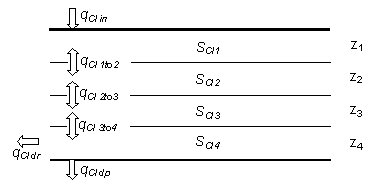Theory
Salt accumulation and transport in the ecosystem can optionally be simulated optional (see switch SaltTracer in the chapter Structure of model). This section describes how salt enters the ecosystem, how it is transported and stored in the soil profile and how it is leached to the groundwater. An overview is given in Figure 2.7. An accumulation of salts in the soil can reduce plant growth, either by a reduced water uptake by increasing the soil osmotic potential (see chapter Plant Water Processes) or from reduced photosynthesis/increased plant metabolism (see section Plant Growth).

Figure 2.7. Storage and fluxes of salt in the soil profile. Symbols are explained in the text below.
It is also possible to expand the salt model to represent the distribution and transport of a trace element (see switch TraceElementUptake) if nitrogen and carbon processes are included in the simulation. This option allows for a passive and/or active plant uptake of the tracer. In the soil, trace elements are not only dissolved in the soil water, but can also be located in humus or litter (so called organic TE) or can be adsorbed to soil particles or soil organic matter.
The trace element application makes use of the salt pools in the model. In other words, when trace elements are included in a simulation, all pools denoted “Salt”, stands for trace element. The trace element application is described in detail at the end of this section.
 Initial values
Initial values